Project Complexity Assignment On Melbourne Metro Rail Project
Question
Task: Write a project complexity assignment illustrating the complexities faced by Melbourne metro rail project.
Answer
1. Definition of a complex project
1.1 Complexity of Melbourne metro rail project explored in the sections of project complexity assignmentThere are several complexities associated with the metro rail project examined in this project complexity assignment that can pose significant challenges to the government. Metro rail construction work generally disrupts public transport systems by blocking the transport routes. There are significant expenses associated with the project. If the expenses are not met it may lead to incomplete construction work. There are several legal issues associated with the work that can influence the different steps of the project development (Dao et al. 2016). There are always chances of physical injury associated with construction work. A major tunnel has to be build that will run through unpredictable ground conditions. There are always chances of major accidents while building a major tunnel because it involves several electrical works.
The ongoing project discussed in this project complexity assignment can disrupt the existing transport and network operations of Australia. Construction works always pose some damage to the surrounding environment and it also affects local heritages and buildings. The vibrations generated from the metro construction works can affect the grip of the land and cause landslides and accidents. There are always chances of major accidents due to blockage of the passage due to dumping of construction materials. It is important to address the major complexities of a project to achieve the definite success and goals of the project (San Cristóbal et al. 2018).
1.2 Differences
The project is complex in terms of planning and coordination (Bakhshi et al. 2016).There are several hindrances that may affect the complexity of a project from the other projects and that is what differentiates a project from a linear project (Lu et al. 2015). The linearity of the project is in terms of usage of construction materials is difficult because it affects the continuity of the resource. This project on project complexity assignment is based on the maintenance of the schedules that requires continuity of the resources from one unit to the next unit. It has to be done to achieve the logical constraints associated with a project along with the management of the cost. The calculations for the costing are done within this project complexity assignment through computational tools that have been developed through data sheets and algorithms. The plot of the project has been designed through computerized methods which represents the approach of the work.
This project is different from a linear project as it does not necessitate building of highways, pipelines or tunnels. But there are few similarities as to gaining permission from the local government authority on the construction work and obtaining environmental restrictions. A metro construction work has to take into account several issues like the safe movement of the equipment’s, safety related to heights, electrical and fireworks along with earth works. The project is different from a linear project on some aspects while it is similar to a linear project on other aspects. The complexity of the project has urged the project manager to undertake strategic construction planning in order to maximize the productivity. The project is also concerned with the sequence or progress that makes it a nonlinear project.
1.3 Uncertainties
Ambiguities in a project cannot be avoided which increases the chances of failure in a project (Floricel et al. 2016). As per the investigation carried on this project complexity assignment, in this project there are few ambiguities that are threatening the very foundation of the project. It is a large project and some of the employees who are assigned with the task are still not clear about their role in the project or what has to be done. There are some changes that have to be done in the policies which require immediate attention of the senior management. Also there is some shortage in the resources that might force the project manager to extend the deadline of the project. There is some improvisation in the costing reports that needs to be justified.
2 Context:-
2.1 Background
The network of railway that currently exists in Melbourne is damaged due to overcapacity and there is shortage of metro trains that is leading to overcrowding of the metros. The Melbourne underground metro rail project has been initiated to resolve the issue and renew the service of more trains in Sunbury, Williamstown, and other railway routes. It has been roughly estimated in the context of project complexity assignment that the increased capacity will support more or less 20000 passengers everyday per hour (Railway technology, 2019). All the passengers can conveniently access the transport service across the loops of the city that will help in lowering the transport traffic on specific tram routes.
The passengers can also access several prominent locations across the city along with the development of infrastructure. [Refer to appendix 2 of project complexity assignment]
2.2 What are the aims and objectives of the project explored in this project complexity assignment?
The new metro rail project has been planned to support the construction of a tunnel that is 9 Km long within Melbourne district of Australia. The main purpose of the project stated in this project complexity assignment is to connect the railway route between Dandenong and Sunbury. This is a very crucial project under the authorities of Government of Victoria and it is also included within the agenda of transport facilitation act 2009. The overall estimated cost of the project calculated within this project complexity assignment is approximately 11 billion dollars. The background planning for the project has started since 2018 and the project will take its place from 2025. The Melbourne metro rail project is intended to create a connected route between Dynon and St. Kilda road. The rail network will cross the Central business district. In this project complexity assignment, it is anticipated that the new metro rail will benefit the Western zones and northern suburban zones of Melbourne district.
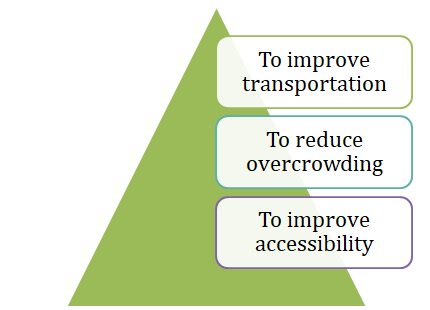
Figure 1: Aims and objectives
(Source: Railway technology, 2019)
The project has considered lying of tracks from the South Kensington to Sunbury corridor along with the construction of two tunnels. It will build two new underground stations in North Melbourne, Parkville, and CBD domains. The metro rail project will also construct a new loop line that will make use of the current city loop .In addition the travelers of Frankston line can easily access the new trains on Sunbury Dandenong line. The new project will also make use of the tunnels in the Northern city loop that will form a new Northern loop line upon completion of the metro rail work. One of the main objectives of the project discussed herein project complexity assignment is to form a new cross city line connecting different lines across Werribeee and Williamstown thus forming a route between Flinders and Southern cross street stations. Apprehensive Studies on the geography of the location has been carried out by the engineers along the route that has been mentioned in the proposal. There has been digging of several boreholes to access the ground water for construction purpose. Efficient investigation on the soil conditions and the landscape has helped in anticipating the plans regarding the disposal of soil and construction materials, such that it does not blocks the roads leading to traffic and public disturbances.
The main intention behind the project is to connect the main railway routes across the major cities to mitigate the transport problem of the citizens. The project illustrated in the present scenario of project complexity assignment is aimed to save the time and cost of transportation that passengers are currently facing due to breakage of routes (Turner & Zolin, 2012). They are unable to travel faster due to lack of rail services that is directly increasing the passenger load on the metros which pass through the main routes.
3 Stakeholders:-
3.1 Evaluation
Melbourne metro railway association has consulted various stakeholder group to specific the incitements in the project along with the proposition of the plan. Different interest areas have been identified while designing the project that needs to be solved in order to avoid critical issues and wrong selection of suppliers (Scott et al. 2015).
|
Project |
Engaged stakeholder |
|
Tunnels |
Fire brigade service Necessary service providers |
|
Western portal |
Association of Kensington |
|
Linkage to Arden metro station |
Association of North and West Melbourne Business and resident association |
|
Linkage to Parkville station |
University of Melbourne Parkville association Hospitals Research and education facilities |
|
Linkage to South station |
Federation management Schools Clinics |
Table 1: Targeted stakeholder group
(Source: Van Offenbeek & Vos, 2016)
As mentioned in this project complexity assignment, the intended stakeholders have supported the overall construction of the metro rail tunnel in order to improve the public transport facilities in Melbourne. But there has been complains regarding the traffic caused due to construction work and its influence on the local streets. The construction work is also hindering the safety of the citizens. There are major concerns on the negative side of the project and its impact on the health of the citizens as well as the environment (Van Offenbeek & Vos, 2016). The metro rail work is known to cause continuous truck movements and generation of noise due to vibration and the equipment’s. Also, it is evident in the project complexity assignment that the public is concerned with the generation of dust that might pollute the environment. Complains have been raised on the behalf of the workers regarding long working hours and tedious working procedures as implemented by the engineers. There have been issues regarding the excessive usage of groundwater and acquisition of underground strata. The publics in Parkville area is mainly tensed about the roadblocks and diversions that has been caused due to the construction work. It is affecting the access to nearby hospitals and colleges.
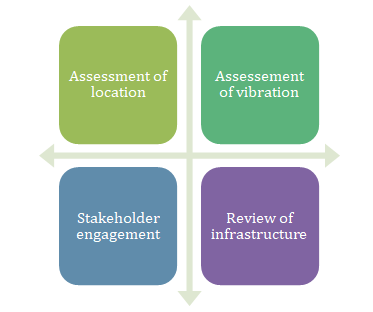
Figure 2: Plans of construction
(Source: Van Offenbeek & Vos, 2016)
Extensive assessment is necessary to identify the optimal location for the project work and maintenance of infrastructure (Turner & Zolin, 2012). The readings utilized to prepare this project complexity assignment signifies that the considerations on design and planning are necessary to minimize the acquisition of property and harmful impacts on the local community (Aaltonen & Kujala, 2016). It is essential to measure the vibrations in order to ensure that no explicit damage will be caused to the buildings due to the construction of the tunnels. More refinement in the design and infrastructural locations can be done to reduce the impact of construction work on the local community.
3.2 Discussion
Complexities may arise during the course of work due to miscommunication and arguments between different disciplines (Diouf & Boiral, 2017). The decrease in the working hours can delay the finishing of the project within the stipulated time. The different stakeholder group can perceive this situation differently. The workers may think that the organization is showing less concern to the health and working spirit of the labors that might generate conflict and mismanagement of the task. The public can perceive the delaying of the project illustrated within this project complexity assignment as a means of casualty and reluctance from the side of the association (Maylor & Turner, 2017). It can also be perceived as a false commitment in regards to volatilization of transport problems for the convenience of the citizens.
3.3 Analysis
According to the research conducted on this project complexity assignment, effective stakeholder management is necessary to gain success in a construction project (Mok et al. 2015).The stakeholders have extended full support to the construction program as it can potentially mitigate the transportation issues with the opening of a new opportunity towards accessing different locations across Melbourne. The community groups have also expressed their interest towards the fact that the construction program can bring lasting changes to the intended area.
|
Plan |
Procedure |
|
Advertisement and promotional activities |
More than 30 advertisements have been published in the newspapers to aware the stakeholders on the project |
|
Communication through digital media |
Engagement of the stakeholders through publication of data in the official website of Melbourne Metro railway association |
|
Communication through internet news |
Daily updates on the proceedings of the task (Butt et al. 2016). |
|
Direct communication |
Meetings and interviews with the stakeholders on explaining the concept of the design and its future impact (Luo et al. 2016) |
Table 2: Communication plan with the stakeholders on the case of project complexity assignment
4 Construction methods:-
4.1 Critical evaluation
- Acquisition of quality raw material for the purpose of construction
- Renewing the sewage facilities to avoid any kind of blockage due to the accumulation of construction debris
- Proof checking of the structures by experienced engineers to avoid the chances of breakage or accidents
- Obtaining feedback from the stakeholders to assess the utility of the project design
- Sufficient investigation on the quality of the land before the development of the design
- Supporting structures and mechanical holdings to increase the strength of the structure.
- Involving the community members and obtaining permission from the land owners and responsible tenants
- Reviewing of project information and regular interaction with the workers to obtain feedback about the proceedings of the project.
- Maintenance of the electrical infrastructure to ensure proper distribution of electricity
- Active engagement of the emergency services of Melbourne metro
- Proper training of the workers to ensure site safety
- Proper designing of the metro railways that can be extended upto 220m to increase the capacity
- Appointment of technical advisors for checking of the lines and their proper insulation
- Appointment of experienced personnel to plan the locations and route of the train.
4.2 Mitigating measures
It is discussed in this project complexity assignment that it is important to implement proper sewage treatment facility to reuse the groundwater and avoid wastage. Communities and stakeholders should be engaged through proper communication in order to generate awareness amongst the public (Leybourne & Kennedy, 2015). It is important to implement warning signs in appropriate places to keep the worker and the local citizen’s alert about the construction work. Implementation of proper waste disposal facilities to avoid the pollution of the environment through generation of solid waste has been carried out. The project design obtained in this project complexity assignment should be set in a way that can minimize the diversion of local routes. Implementation of environment assessment programs to measure the performance of the project and its impact on the environment (Verweij, 2015). Proper training should be provided to the workers so that they work according to the safety regulations (Kivilä et al. 2017).
Implementation of proper methodology is important to ensure the success of a project (Joslin & Müller, 2016).Workshops is conducted to attend the issues that have been raised by the communities and the stakeholders. It is recommended in this context of project complexity assignment to fence the area in order to avoid accidents along with usage of advanced equipment’s that will reduce the generation of noise. It is evident that dusts will be generated due to construction work but proper working techniques should be implied to avoid the spread of the dust that might harm the environment and the people (Kazadi et al. 2016). Technical specialists and designing experts should ensure that the structure is rigid enough to bear major earthquakes. Proper allocation of construction materials is necessary to reduce the congestion of the roads. Proper traffic management can initiate the accessibility to local community facilities.
5. Technology-enhanced construction practice:-
5.1 Discussion on the use of technology
The project of the Melbourne metro tunnel involves the construction of a long 9 km tunnel for the Melbourne city. It came as a new move in connecting the Sunbury and Dandenong railway routes of Melbourne. The earlier rail networks of Melbourne were immensely over packed and therefore the only solution that came up for it was the construction of underground rail tunnel. Such an enhanced railway network required a good amount of technical assessment (Aljassmi, Han & Davis, 2015). The metro rail tunnel saw the installation of a new signaling system that came out as a great help for the metro trains to pass by the new entrances that were carried out in every two to three minutes. As opined by Eriksson (2017) in regards to the study prepared in this project complexity assignment, this new signaling technology helped the trains to move in every direction within an interval of a few minutes. The metro tunnel of Melbourne saw the use of carbon emission abatement technology being used with the engines of the metro rails. This came as an advanced form of technology implementation for the fuel consumption factors for the metro rails. As influenced by Fulk & Connie Yuan (2017) within this project complexity assignment, the metro tunnel construction saw the use of highly advanced information and construction technology. It saw the application and implementation of cloud-based projects, which were easily molded, within the digital and user-friendly interface of the work environment.
5.2 Proposition
The metro tunnel of Melbourne was brought into existence to solve the over congestion and space limitation that the city was facing through. Thus, metro tunnels could have implemented the use of the New Australian Tunneling Method (NATM). This technological tool would have helped the contractors to broaden and widen the space area for the tunnel construction underground. This would have in turn provided additional space for the station constructions for the Melbourne city in the underground channels. This model tunneling technological tool explored in the project complexity assignment would have helped the city to effectively mitigate the congested space problem that the city was facing. The new form of technological tools for the tunnel creation would have effectively enhanced the service of the first underground metro tunnel of the city. The tunnels could have widened by the use of technological tools like breakers and controlled blaster areas of the underground tunnels. Tunnels are dark areas and the construction process within the tunnels becomes more complex with the problem of lights. Thus, the contractors of the Melbourne metro tunnel projects (3D Laser Mapping, 2019) could have implemented the process monitor tool. This particular tool has these potential to carry out the use of pulse light from a laser machine to carry out the measurement aspects within the tunnel in low light conditions.
This tool mentioned in this project complexity assignment would have made the construction and measurement aspects within the Melbourne tunnel more accurate in nature. Besides, this tool would also have easily dealt with the safety factors. The tunnel construction projects are essentially time-consuming and very complex in form. This was a similar case for the construction of the Melbourne metro tunnel as it involved a good assessment of a large number of technical and environmental assessment factors. These factors were essential considerations. Thus, the concerned constructor could have implemented the 3D data set the technological tool in a combination with an automated mode of software (3D Laser Mapping, 2019). This would have made it possible to live stream the tunnel construction process. This would help the complex project to be finished in a timely manner and within the estimated period of 2025. Both these technological tools would help the Melbourne construction to have effective results by the facilitation of simple methods. [Refer to Appendix 3 of project complexity assignment]
6. Procurement and contract administration
6.1 Outline on the type of contract
The early construction of the Melbourne underground metro tunnel has been given to an Australian based company namely John Holland. A large number of Australian companies have been given the charge for construction of the Melbourne metro tunnel. As opined by Zhang et al. (2018), the construction process has been split out among a large number of global companies to facilitate an effective construction process. The construction project would see more than 1000 people carrying out the construction work.
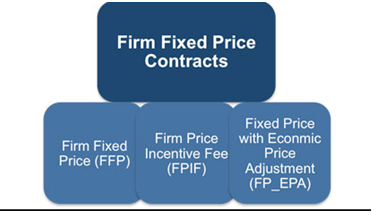
Figure 3: Types of Firm Fixed Price Contracts
(Source: Gardiner, Janssen & Kirchner, 2016)
As depicted in the above figure provided within this project complexity assignment, firm fixed contracts are of three types. The Melbourne metro tunnel project encompasses the use of Fixed Price with Economic Price Adjustment Incentive Fee Model (FPIF), for the contract process. This type of contract is carried out for complex, risky and projects, which are to be carried for a span of multiple years (Ju Ding & Skibniewski, 2017).
6.2 Discussion on the contract chosen in this project complexity assignment
John Holland KBR carried out the early years of the metro tunnel constructions, like service relocation for the people and carrying out of the construction sites. A partnership was visible among the Cross Yarra Partnership, John Holland construction and Capella Capitals for the process of building new tunnels and stations for the Melbourne project. The Beon Energy firm of Australia carried out the power construction processes. The entire rail system with the signaling and the integration systems were carried out by another group named Yarra Trams. The contractor group of CPB, AECOM, and John Holland groups carried out the essential areas of tunnel portals and the process of realignment of the already existing railway lines within Melbourne with the new ones.[Refer to Appendix 2]
6.3 Affect
The FP-EPA contract that has been carried out in the Melbourne metro tunnel project would allow a readjustment process to the contractor in terms of the price and contract rate (Larsen et al. 2016). This form of contract as opined by Lavikka, Smeds & Jaatinen (2015) within this project complexity assignment, thus, would have provided a large number of contractors within the concerned project the special provision of price adjustments with the rising cost of the raw materials and factors of production with the coming years (Luo et al. 2016). A large number of dynamic changes would have taken place from the 2016 time. This form of contact as noted in the project complexity assignment came out to be beneficial for not only the contractors but also the stakeholders in the Melbourne project. As a particular contract type gives the stakeholders also a chance to carry out price adjustments with the changing market demands and situations.
7. Project planning
7.1 Intent of construction planning
The Construction of the metro tunnel for the Melbourne city was a gigantically complex process. It had a large number of obstacles in its process of building (Ma, 2017). A large number of houses had to disrupt to carry out the construction. The already existing underground infrastructures like the city links, city loops and the other services like water and electricity had to be effectively maintained. The project complexity assignment utilized the readings of Williams (2016) that a large number of geological challenges like rock, clay, sand, and silt had to be faced. Along with this, the decomposition of the large excavated material was also a matter of concern in the project. To handle these essential challenges a large number of construction techniques were implemented in the project like the CBD excavation.

Figure 4: Melbourne Metro Tunnel Project
(Source: Big Building, 2019)
The above figure provided within this project complexity assignment demonstrates the timeline of the Melbourne Metro project from the time of 2016 up till 2025. The figure primarily states the project developments that have been carried out on a yearly basis.
This technique, for example, gives access to shafts for the transportation of workers and machinery (Metro Tunnel, 2019). This in totality highly lessened the disruption process of the ground during the construction process. The trinocular excavation techniques had been implemented within the stations of the Town Hall and Station Library. This came as a large helping process to mitigate the problems carried out by the geological factors (Mok, Shen & Yang, 2015). One of the most important challenges addressed in this segment of project complexity assignment that the project had in facing was the fact that the tunnel would be carried out under the Yarra River. Thus, to minimize the challenges of the high flowing Yarra River, the project implemented the use of tunnel boring machines for the tunneling process.
7.2 Risk management approach
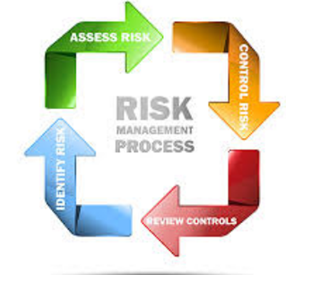
Figure 5: Risk Management Components
(Source: Mottaeva, A. 2017, October)
The above risk management approach illustrated within this project complexity assignment demonstrates the four steps that could be implemented to mitigate the varied risks that are involved with the complex construction process of the Melbourne Metro tunnel. As opined by Orekhova et al. (2018), a large number of environmental and technical factors have emerged as the most risking factor in the project. As stated in this project complexity assignment, the first step in the risk management process would be to identify the risk factors. The facilitation of the tunneling process under such a heavy flowing Yarra River along with the management of millions of cubic meters of excavated material during the construction process remains the most essential risk factors for the project (Qazi et al. 2016). As stated by Sardroud (2015), the tunnel building process has the components of building twin tunnels around 10 meters under the riverbed. Therefore, it created huge risk factors for the safety of passengers. The most efficient reviewing and controlling aspect for the risk was the use of tunnel boring machines for the under tunnel construction. The excavated materials disposition would be another important risk factor. A lack in the decomposition of the material would have led to the pollution of the environment and surrounding areas. A 24-hour truck process for waste decomposition was carried out. Along with it, the main controlling aspect that was implemented was the disposal of the contaminated excavated materials along the line of Environmental Protection Authority of Victoria and under the work safety guidelines of Victoria.
8. Conclusion and Recommendations
8.1 Critical evaluation
The above project has been carried out on the metro tunnel project that of Melbourne. It was started around 2016 and has the completion period in the year 2025. The report on project complexity assignment has carried out a good amount of analysis of the various complex factors that had risen in front of the contractors and the stakeholders. This comprised of the ecological, technician and the excavated waste material challenges. The project complexity assignment has also carried out an understanding of the stakeholders in the project, the problems and the benefits that the stakeholders of the project are effectively dealt with here. The varied methods of construction that were implemented by the varied contract groups have been summarized in this report on project complexity assignment. The varied technological tools that were put into use and could have been used into the project like the monitor technology and the 3D technology is highlighted here. The type of contract agreement, the chosen contract processes, and the contractors have been summarized here. An enhanced planning process along with their risk management approach has been given here.
8.2 Analysis
The construction project could have put into use along with a variety of 3D technologies for the easy facilitation of the project. The monitoring tool would have helped the company to carry out a good evaluation and measurement of the processes that were required in the construction. The contractual type that was carried out could have had the ceiling factor within it. This would have helped both the contractor and the buyers to carry out a profit margin for both of them. Along with it, the contractors could have put new boring technologies into use. This would have helped to mitigate the problems that could emerge anytime due to the flow of the Yarra River over the metro tunnel.
8.3 Introduction of techniques
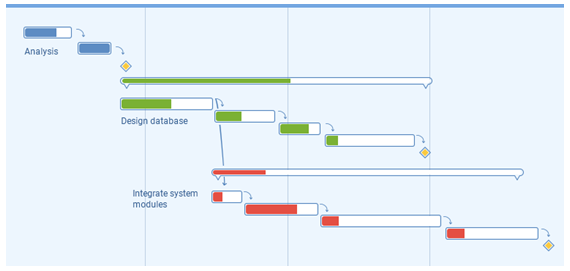
Figure 5: Waterfall Management tool
The metro tunnel project examined in this project complexity assignment could implement the use of waterfall management techniques for their project. It is one of the most classic management techniques for the facilitation of projects. It involves the performance of varied tasks in a sequential manner. The progress report on project complexity assignment could be analyzed through Gantt charts. A complex project like the metro tunnel construction would effectively facilitate this management process. The technique requires the fulfillment of the prior task before the next subtask could be carried out.
Reference List
3D Laser Mapping, (2019). Tunneling Retrieved from https://www.3dlasermapping.com/tunnel-construction/ project complexity assignment Retrieved on 11th May 2019
Aaltonen, K. & Kujala, J., (2016). Towards an improved understanding of project stakeholder landscapes. International Journal of Project Management, 34(8), pp.1537-1552. Retrieved from < https://fenix.tecnico.ulisboa.pt/downloadFile/1689468335568418/1%20Monday%20(2)%20Towards%20an%20improved%20understanding%20of%20project%20stakeholder%20landscapes%20www.elsevier.com:locate:ijproman.pdf >
Aljassmi, H., Han, S., & Davis, S. (2015). Analysis of the complex mechanisms of defect generation in construction projects. Journal of Construction Engineering and Management, 142(2), 04015063. Retrieved from file:///D:/Sneha%20Pandey/may/16th%20may/resources/whole%20(1).pdf Retrieved on 11th May, 2019
Bakhshi, J., Ireland, V. & Gorod, A., (2016). Clarifying the project complexity construct: Past, present and future. International Journal of Project Management, 34(7), pp.1199-1213. Retrieved from < https://www.researchgate.net/profile/Javad_Bakhshi/publication/304725993_Clarifying_the_project_complexity_construct_Past_present_and_future/links/5a373951aca27247ede1caa6/Clarifying-the-project-complexity-construct-Past-present-and-future.pdf >
Big Building (2019). Metro Tunnel. Retrieved from https://bigbuild.vic.gov.au/projects/metro-tunnel Retrieved on 11th May 2019
Butt, A., Naaranoja, M. & Savolainen, J., (2016). Project change stakeholder communication. International Journal of Project Management, 34(8), pp.1579-1595. Retrieved from < http://www.projcp.com/Readings/180329%20Stakeholder%20Coms.pdf >
Diouf, D. & Boiral, O., (2017). The quality of sustainability reports and impression management: A stakeholder perspective. Accounting, Auditing & Accountability Journal, 30(3), pp.643-667. Retrieved from < https://corpus.ulaval.ca/jspui/bitstream/20.500.11794/15571/2/The%20quality%20of%20sustainability%20reports%20and%20impression%20management%20A%20stakeholder%20perspective.pdf >
Eriksson, P. E. (2017). Procurement strategies for enhancing exploration and exploitation in construction projects. Project complexity assignment Journal of Financial Management of Property and Construction, 22(2), 211-230. Retrieved from https://www.emeraldinsight.com/doi/pdfplus/10.1108/JFMPC-05-2016-0018 Retrieved on 11th May, 2019
Floricel, S., Michela, J.L. & Piperca, S., (2016). Complexity, uncertainty-reduction strategies, and project performance. International Journal of Project Management, 34(7), pp.1360-1383. Retrieved from < http://eprints.bbk.ac.uk/21366/1/OA%20Floricel%20Michela%20Piperca%202016%20Uncertainty.pdf >
Fulk, J., & Connie Yuan, Y. (2017). Social Construction of Communication Technology. The International Encyclopedia of Organizational Communication, 1-19. Retrieved from https://www.researchgate.net/profile/Y_Connie_Yuan/publication/313658973_Theoretical_contributions_to_the_social_construction_paradigm_in_organizational_communication/links/5aafb51fa6fdcc1bc0bd00ff/Theoretical-contributions-to-the-social-construction-paradigm-in-organizational-communication.pdf Retrieved on 11th May, 2019
Gardiner, J. B., Janssen, S., & Kirchner, N. (2016, January). A realization of a construction scale robotic system for 3D printing of complex formwork. In ISARC 2016-33rd International Symposium on Automation and Robotics in Construction. Retrieved from https://opus.lib.uts.edu.au/bitstream/10453/100622/1/Robotic%20system%20paper%20(1).pdf Retrieved on 11th May, 2019
Joslin, R. & Müller, R., (2016). The impact of project methodologies on project success in different project environments. Project complexity assignment International Journal of Managing Projects in Business, 9(2), pp.364-388. Retrieved from < https://www.researchgate.net/profile/Robert_Joslin/publication/295857531_The_impact_of_project_methodologies_on_project_success_in_different_project_environments/links/59e07e3ca6fdcca98432421d/The-impact-of-project-methodologies-on-project-success-in-different-project-environments.pdf>
Ju, Q., Ding, L., & Skibniewski, M. J. (2017). Optimization strategies to eliminate interface conflicts in complex supply chains of construction projects. Journal of Civil Engineering and Management, 23(6), 712-726. Retrieved from file:///D:/Sneha%20Pandey/may/16th%20may/resources/1155-Article%20Text-2391-1-10-20180412.pdf Retrieved on 11th May, 2019
Kazadi, K., Lievens, A., & Mahr, D. (2016). Stakeholder co-creation during the innovation process: Identifying capabilities for knowledge creation among multiple stakeholders. Journal of Business Research, 69(2), 525-540. Retrieved from < file:///D:/16.05/res/127743_2018_06_11%20(1).pdf >
Kivilä, J., Martinsuo, M., & Vuorinen, L. (2017). Sustainable project management through project control in infrastructure projects. International Journal of Project Management, 35(6), 1167-1183. Retrieved from < http://e-tarjome.com/storage/panel/fileuploads/2019-02-20/1550663922_E10656-e-tarjome.pdf >
Larsen, J. K., Shen, G. Q., Lindhard, S. M., & Brunoe, T. D. (2015). Factors affecting schedule delay, cost overrun, and quality level in public construction projects. Journal of Management in Engineering, 32(1), 04015032. Project complexity assignment Retrieved from http://ira.lib.polyu.edu.hk/bitstream/10397/62462/1/Larsen_Jesper_Kranker_2015.pdf Retrieved on 11th May, 2019
Lavikka, R. H., Smeds, R., & Jaatinen, M. (2015). Coordinating collaboration in contractually different complex construction projects. Supply chain management: an international journal, 20(2), 205-217. Retrieved from https://www.researchgate.net/profile/Rita_Lavikka/publication/272784870_Coordinating_collaboration_in_contractually_different_complex_construction_projects/links/5b1b96dc0f7e9b68b42a40f5/Coordinating-collaboration-in-contractually-different-complex-construction-projects.pdf Retrieved on 11th May, 2019
Leybourne, S. & Kennedy, M., (2015). Learning to improvise, or improvising to learn: Knowledge generation and ‘Innovative Practice’in project environments. Knowledge and Process Management, 22(1), pp.1-10. Retrieved from < http://blogs.bu.edu/sleyb/files/2016/09/kpm1457-final-pdf.pdf >
Lu, Y., Luo, L., Wang, H., Le, Y., & Shi, Q. (2015). Measurement model of project complexity for large-scale projects from task and organization perspective. International Journal of Project Management, 33(3), 610-622. Retrieved from < http://or.nsfc.gov.cn/bitstream/00001903-5/356802/1/1000013406736.pdf>
Luo, L., He, Q., Xie, J., Yang, D. & Wu, G., (2016). Investigating the relationship between project complexity and success in complex construction projects. Journal of Management in Engineering, 33(2), p.04016036. Retrieved from < https://www.researchgate.net/profile/Lan_Luo10/publication/305663539_Investigating_the_Relationship_between_Project_Complexity_and_Success_in_Complex_Construction_Projects/links/59e2d808a6fdcc7154d81fc4/Investigating-the-Relationship-between-Project-Complexity-and-Success-in-Complex-Construction-Projects.pdf >
Luo, L., He, Q., Xie, J., Yang, D., & Wu, G. (2016). Investigating the relationship between project complexity and success in complex construction projects. Journal of Management in Engineering, 33(2), 04016036. project complexity assignment Retrieved from https://www.researchgate.net/profile/Lan_Luo10/publication/305663539_Investigating_the_Relationship_between_Project_Complexity_and_Success_in_Complex_Construction_Projects/links/59e2d808a6fdcc7154d81fc4/Investigating-the-Relationship-between-Project-Complexity-and-Success-in-Complex-Construction-Projects.pdf Retrieved on 11th May, 2019
Ma, Z. (2017). Research on Dynamic Simulation of Virtual Reality Technology in Landscape Architecture Construction. Revista de la Facultad de Ingeniería, 32(5). Retrieved from file:///D:/Sneha%20Pandey/may/16th%20may/resources/1756-3611-1-SM.pdf Retrieved on 11th May, 2019
Maylor, H. & Turner, N.,( 2017). Understand, reduce, respond: project complexity management theory and practice. International Journal of Operations & Production Management, 37(8), pp.1076-1093. Retrieved from < https://ora.ox.ac.uk/objects/uuid:2636d744-a3d8-42e3-935b-5098e9970b4c/download_file?file_format=pdf&safe_filename=2016%2BIJOPM%2BComplexity%2BAAM.pdf&type_of_work=Journal+article >
Metro Tunnel (2019). BUILDING THE TUNNELS AND STATIONS. Retrieved from https://metrotunnel.vic.gov.au/construction/building-the-tunnels-and-stations Retrieved on 11th May, 2019
Mok, K. Y., Shen, G. Q., & Yang, J. (2015). Stakeholder management studies in mega construction projects: A review and future directions. International Journal of Project Management, 33(2), 446-457. project complexity assignment Retrieved from https://fenix.tecnico.ulisboa.pt/downloadFile/1689468335567430/1%20Wednesday%20-%20%20Stakeholder%20management%20studies%20in%20mega%20construction%20projects-%20A%20review%20and%20future%20directions.pdf Retrieved on 11th May, 2019
Mok, K.Y., Shen, G.Q. & Yang, J., (2015). Stakeholder management studies in mega construction projects: A review and future directions. International Journal of Project Management, 33(2), pp.446-457. Retrieved from < https://fenix.tecnico.ulisboa.pt/downloadFile/1689468335567430/1%20Wednesday%20-%20%20Stakeholder%20management%20studies%20in%20mega%20construction%20projects-%20A%20review%20and%20future%20directions.pdf >
Mottaeva, A. (2017, October). Innovative project management on the basis of programme-and-target approach for energy saving in the construction complex. In IOP Conference Series: Earth and Environmental Science (Vol. 90, No. 1, p. 012124). IOP Publishing. Retrieved from https://iopscience.iop.org/article/10.1088/1755-1315/90/1/012124/pdf Retrieved on 11th May, 2019
Orekhova, T. N., Nosov, O. A., Prokopenko, V. S., & Kachaev, A. E. (2018, March). Complex modeling of technological processes in pneumatic mixers for production of dry construction mixtures. In IOP Conference Series: Materials Science and Engineering (Vol. 327, No. 2, p. 022084). IOP Publishing. Retrieved from https://iopscience.iop.org/article/10.1088/1757-899X/327/2/022084/pdf Retrieved on 11th May, 2019
Qazi, A., Quigley, J., Dickson, A., & Kirytopoulos, K. (2016). Project Complexity and Risk Management (ProCRiM): Towards modelling project complexity driven risk paths in construction projects. Project complexity assignment International Journal of Project Management, 34(7), 1183-1198. Retrieved from https://strathprints.strath.ac.uk/56510/1/Qazi_etal_IJPM_2016_towards_modelling_project_complexity_driven_risk_paths_in_construction_projects.pdf Retrieved on 11th May, 2019
Railway technology, (2019). Background to Melbourne’s metro project. Retrieved from < https://www.railway-technology.com/projects/melbourne-metro-rail-project/ > [Accessed on 7 May, 2019]
San Cristóbal, J. R., Carral, L., Diaz, E., Fraguela, J. A., & Iglesias, G. (2018). Complexity and Project Management: A General Overview. Complexity, 2018. Retrieved from < file:///D:/16.05/res/4891286%20(1).pdf>
Sardroud, J. M. (2015). Perceptions of automated data collection technology use in the construction industry. Journal of Civil Engineering and Management, 21(1), 54-66. Retrieved from file:///D:/Sneha%20Pandey/may/16th%20may/resources/2998-Article%20Text-6475-1-10-20180619.pdf Retrieved on 11th May, 2019
Scott, J., Ho, W., Dey, P.K. & Talluri, S., (2015). A decision support system for supplier selection and order allocation in stochastic, multi-stakeholder and multi-criteria environments. International Journal of Production Economics, 166, pp.226-237. Retrieved from < https://www.sciencedirect.com/science/article/pii/S0925527314003582 >
Turner, R. & Zolin, R., (2012). Forecasting success on large projects: developing reliable scales to predict multiple perspectives by multiple stakeholders over multiple time frames. Project complexity assignment Project Management Journal, 43(5), pp.87-99. Retrieved from < http://www.mega-project.eu/assets/exp/resources/2012_PMJ_Turner_Zolin_final_3.pdf>
Van Offenbeek, M.A. & Vos, J.F., (2016). An integrative framework for managing project issues across stakeholder groups. International Journal of Project Management, 34(1), pp.44-57. Retrieved from < http://www.projcp.com/Readings/180329%20Stakeholder%20Issues.pdf >
Verweij, S. (2015). Once the shovel hits the ground: Evaluating the management of complex implementation processes of public-private partnership infrastructure projects with qualitative comparative analysis. Retrieved from < file:///D:/16.05/res/s.verweij_Red%20(1).pdf >
Williams, T. (2016). Identifying success factors in construction projects: A case study. Project Management Journal, 47(1), 97-112. Retrieved from https://sewell-construction.co.uk/wp-content/uploads/sites/2/2016/07/Williams-2016-Project_Management_Journal.pdf Retrieved on 11th May, 2019
Zhang, L., Chen, H., Li, H., Wu, X., & Skibniewski, M. J. (2018). Perceiving interactions and dynamics of safety leadership in construction projects. Safety science, 106, 66-78. project complexity assignment Retrieved from https://www.researchgate.net/profile/Hong_Xian_Li/publication/323693073_Perceiving_interactions_and_dynamics_of_safety_leadership_in_construction_projects/links/5aa5b20445851543e6413305/Perceiving-interactions-and-dynamics-of-safety-leadership-in-construction-projects.pdf Retrieved on 11th May, 2019
Appendices
Appendix 1: Team Collaboration and Management
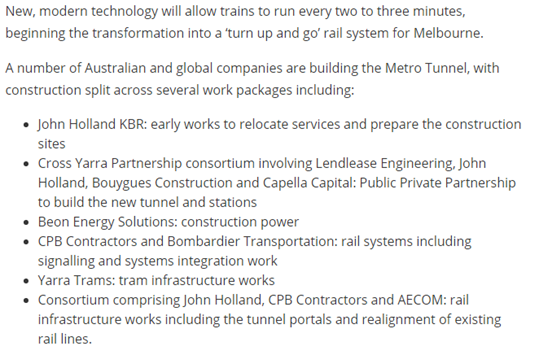
(Source: Metro Tunnel, 2019)
Appendix 2: Overview of the Melbourne metro project
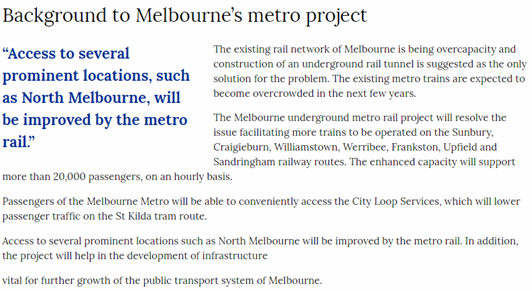
(Source: Railway technology, 2019)
Appendix3: Construction Management Technology on the Jobsite
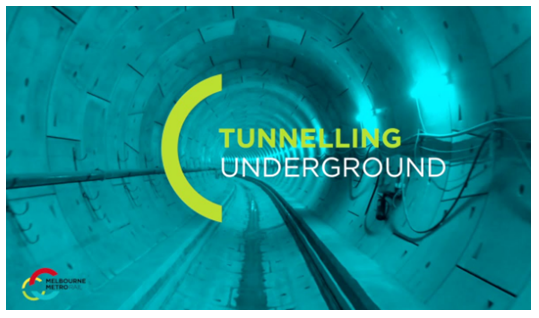
(Source: Big Building, 2019)












